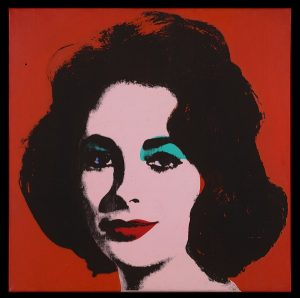What is there left to say about Andy Warhol? He was one of a handful of 20th-century artists who truly became household names, like Picasso. He was a hugely successful pop artist in the 1960s, even if others like Robert Rauschenberg and Jasper Johns were more influential and inventive. His work captured the age, despite or because it often seemed commercial and cynical.
The full sweep of Warhol’s output is now on view in “Andy Warhol—From A to B and Back Again,” a sprawling exhibition at the San Francisco Museum of Modern Art. It’s an exhilarating—and exhausting—tour of more than 300 works, from paintings, drawings, and sculpture to film, video, books, and magazines. Organized by the Whitney Museum of American Art in New York, where the show ran from November through March, it’s a must-see.
Born Andrew Warhola and raised in a working-class Slovakian family in Pittsburgh, Andy was a shy, often sickly gay boy who studied art at Carnegie Institute of Technology. After college, he moved to New York in 1949 to become a commercial artist, creating fanciful drawings of women’s shoes, and began experimenting with his own artworks. (Perhaps reflecting his social ambitions, he also changed his name to Warhol and got a nose job.) By the late 1950s he was showing his own paintings and drawings in small galleries in New York.

The SFMOMA exhibition begins with Warhol’s breakthrough period in the early 1960s. There are drawings and paintings that riff on tabloid newspaper pages (“Pirates Sieze Ship,” “Sinatra and His Rat Pack”) and imagery from popular culture (Superman, Dick Tracy, Coke bottles, Brillo boxes, those Campbell’s Soup cans). This early work already includes his signature features: using photographs as the source for his paintings; repeating silkscreened images, with variations in color and saturation from one to the next; and a tongue-in-cheek tone that could be read as adulation or criticism of American postwar culture, or both.
The SFMOMA exhibition, across more than a dozen galleries, takes up style after style, theme after theme. First are the big silkscreens of celebrities such as Triple Elvis of 1963 (above), with three black-on-silver images of the singer dressed as a cowboy and pulling a six-shooter on the viewer, or Silver Marlon from the same year, a double image of the actor in a black leather jacket, sitting on his motorcycle in The Wild Bunch. (Warhol had a thing for celebrities.)
There are also female icons including Marilyn Monroe, Jackie Kennedy, and Elizabeth Taylor. Liz #6 (Early Colored Liz) is a classic example of the square silkscreen portraits that became his most famous, and lucrative, genre. Based on a film publicity photo, the actress offers an enigmatic smile and is rendered in four saturated colors: a rosy pink for the face, black for the hair and shadows, deep red for the lips and background, and a bit of green eye shadow.

Other themes are darker, including a room full of “death and disasters” such as electric chairs, taxi crashes, and police dogs attacking civil rights protesters. (Two galleries on separate floors from the main exhibition feature Warhol’s early work as a commercial illustrator, as well as his films, videos, and dozens of his commissioned silkscreen portraits, a business that supported the other work at his studio, known as the Factory.)
By 1966, Warhol started to step away from painting to focus on filmmaking, publishing, and other projects. In 1968, he was shot by a radical feminist and hanger-on at the Factory and almost died. After a long recovery, his work took on a more somber tone, sometimes with overt political themes (portraits of Chairman Mao, a silkscreen of a deranged-looking Richard Nixon with his face painted green and titled “Vote McGovern” at the bottom).
He also returned to deathly images, such as Skull of 1976, a silkscreen portrait of a blue human skull sitting on a black and yellow tabletop, or Gun of 1981-82, featuring a snub-nosed pistol rendered in red and black.
In this period Warhol also addresses the issue of sexual identity more overtly, with a series of silkscreen portraits of drag queens and transsexuals, as well as a series of Polaroid photos of himself in a woman’s wig, an off-the-shoulder dress, and other costumes.

Late in his career and perhaps running low on energy or inspiration, Warhol collaborated with the rising art star Jean-Michel Basquiat on a series of paintings. In Paramount of 1984-85, Warhol contributed a big red Paramount Pictures logo to the rectangular canvas, and Basquiat supplied almost everything else: doodles, random words and numbers, small cartoonlike drawings of silhouetted black heads, rocket ships, windows, a man drowning. Most importantly, Basquiat supplied the energy and inventiveness.
Warhol died in 1987, at age 58, shortly after undergoing surgery. He was buried in Pittsburgh next to his parents’ graves.
“Andy Warhol—From A to B and Back Again” runs through September 2 at the San Francisco Museum of Modern Art, 151 Third Street, and will be on view at the Art Institute of Chicago from October 20 through January 26, 2020. An extensive catalog is published by the Whitney Museum and Yale University Press.
(Top image: Andy Warhol, Triple Elvis (Ferus Type), 1963; acrylic, spray paint, silkscreen ink on linen. The Doris and Donald Fisher Collection at the San Francisco Museum of Modern Art, (c) The Andy Warhol Foundation for the Visual Arts Inc. / Artist Rights Society (ARS), New York.)
